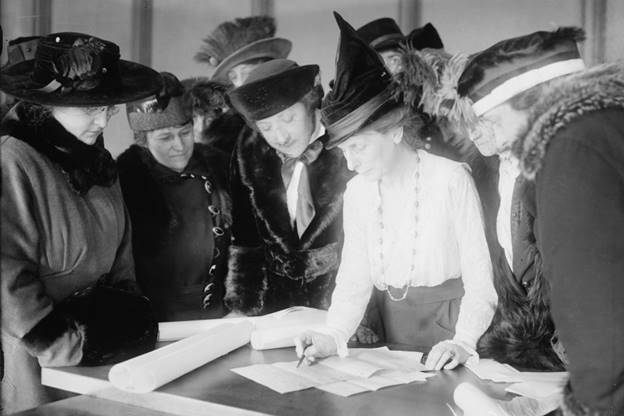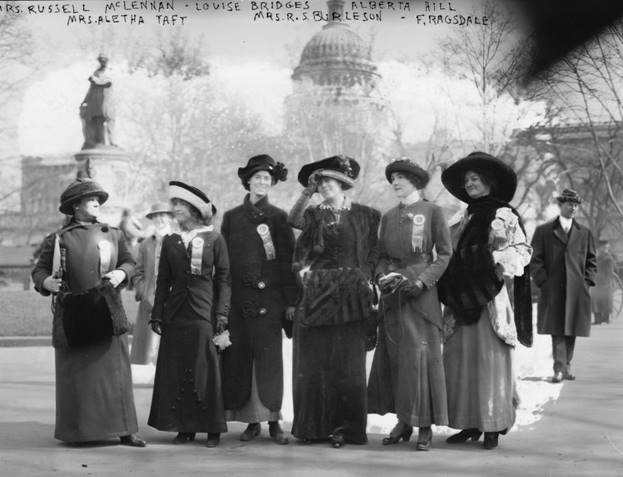
Suffragist Bertha M. Furman (center), who worked for the League of Women Voters, teaches women how to vote. Photo, taken circa 1915, courtesy of the George Grantham Bain Collection/Library of Congress.
One hundred years ago Tuesday, Aug. 17, U.S. women were granted the right to vote.
The ratification of the 19th Amendment was a historic achievement that followed a more-than-70-year fight by women’s suffrage activists. These women went to great lengths for the right to vote, from picketing in front of the White House to lobbying in political settings where they were not allowed. Many were arrested.
Because of this long-fought suffrage movement, women now are just as involved in political causes as men. In many elections of the past several years, women have outpaced men in percentage of voters.
Marian Mollin, an associate professor of history at Virginia Tech, studies U.S. women’s history and social and political movements. Here she offers her thoughts on the anniversary of the 19th Amendment and its significance for society then and now.
Question: How did the fight for women’s suffrage begin?
Mollin: It began in 1848 with the women’s rights convention in Seneca Falls, N.Y. Many people point to this convention as the beginning of the women’s suffrage movement since it brought women’s rights activists together politically.
But the process to advance these rights took far longer than activists at the time expected. The struggle spanned multiple generations and lasted so long that the women who started it died by the time that the suffrage amendment passed in 1920. It took more than 70 years for them to achieve one of their main goals: the right to vote.
Question: Was the movement about more than gaining the right to vote?
Mollin: The women’s rights movement of 1848 had a pretty broad agenda, which activists articulated in their Declaration of Sentiments, a document that intentionally mimicked the Declaration of Independence in form and function. This declaration had a range of demands — property rights, education, divorce, job opportunities, political representation — which ultimately became one issue, which was voting. It’s wrong to think that suffrage takes care of all of those other issues.
Voting is important because legislation is how you gain the ability to advance and protect a movement’s achievements. But voting was just one piece of a larger agenda. Without voting, you have no voice, and you need that voice. But voting on its own doesn’t solve everything.
 A band of suffragists — including Mrs. Russell McLennan, Aletha Taft, Louise Bridges, Mrs. Richard Coke Burleson, Alberta Hill, and F. Ragsdale — gather in front of the Capitol Building in Washington, D.C., on March 3, 1913. A hand-scrawled notation at the top of the photo captures the irony that two of the women were identified by their husband’s names. Photo courtesy of the Library of Congress.
A band of suffragists — including Mrs. Russell McLennan, Aletha Taft, Louise Bridges, Mrs. Richard Coke Burleson, Alberta Hill, and F. Ragsdale — gather in front of the Capitol Building in Washington, D.C., on March 3, 1913. A hand-scrawled notation at the top of the photo captures the irony that two of the women were identified by their husband’s names. Photo courtesy of the Library of Congress.
Question: How did the ratification of the 19th Amendment change women’s lives?
Mollin: It changed both women’s lives and men’s lives, and it did more than just admit women into the voting booth. By the early 1900s, women had already been moving into the public sphere, into the world of business, commerce, education and labor. Politics remained what I call a “no-women’s-land.”
Politics, because it was limited to men, was a place that men used to define their masculinity. So what did that mean when women could be political, too? It was a very clear statement that the entirety of the public sphere was now open to women; it was not just a male space anymore. And it meant that women could now be treated as full citizens with all of the rights that citizenship entails.
Question: What did the amendment fail to accomplish?
Mollin: Not all women had the same agenda, the same concerns and the same obstacles. This was one of the limitations of the suffrage movement. At the time, activists used the language of “woman’s rights,” which implied a singularity of experience, purpose and goals. But this singularity simply did not exist.
One of the things that the suffragists thought would happen, and the anti-suffragists feared would happen, is that women would vote as a bloc to reform society in ways that men in power did not necessarily want to occur. That did not happen. Even from the beginning, women were active in both political parties and held a range of political beliefs, as is true today. Women occupy all parts of the political spectrum.
Question: Did the 19th Amendment mean that all women could vote?
Mollin: Technically, yes. The 19th Amendment applied to all women who were American citizens. In practice, that meant that women of different races and classes had different access to the vote, access that mirrored that held by men of their same social location and status.
White middle-class women could easily access the ballot just like their husbands, fathers, brothers and sons. Women of color, however, faced numerous barriers.
African American women in northern states were generally able to put their suffrage rights into practice. But Black women in the South, like their Black male counterparts, found it almost impossible to enter the voting booth due to discriminatory Jim Crow laws intended to disenfranchise African Americans. Some of these laws also effectively disenfranchised poor Southern white women and men.
Question: What can we learn now from this historic movement?
Mollin: One of the main lessons is about making a commitment to the long haul. We live in a time where we want immediate gratification. It’s hard to think that you’re pushing for something now, and it could be 70 years before there is even a partial solution. What does it take to remain committed to a struggle even though you may not see the successes you’re hoping to achieve?
These women believed that what they were doing was important and necessary. They were committed to it, and they had faith and hope that if they kept doing it others would take up the mantle.


